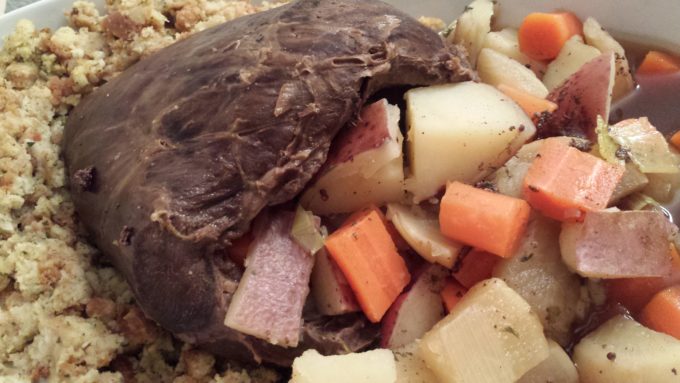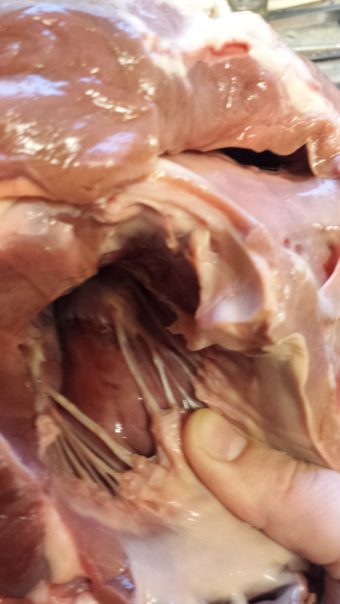
Moose heart served with root vegetable soup and stiffing.
I know eating a moose’s heart will be a brand new idea for many, or most, of our viewers. Hopefully it’s mere mention has not already caused you to click to something else… and as you are now reading this sentence I can see that it hasn’t, and I am very grateful. Thank you.

A moose heart can be a pretty large piece of meat.
So let’s start by taking the ‘bazaar food’ factor out of eating moose heart. Meat is meat is meat is meat. More so, I should say muscle is muscle is muscle is muscle. What I mean is that if you like eating steak or ham or fish, you are eating another living thing’s muscles. Although I will admit that not all organ meat is created equal. (The liver is a very different beast of it’s own.) The heart, just as the tongue, is simply nothing more than a less (severely less) fatty piece of meat. It is indeed pretty much pure muscle. And the only thing that means is that you need to cook it longer if you want it to be tender.
The heart, being the amazing blood pumper that it is, lends itself to some creative and unique opportunities that other meats do not; you can stuff it! There is a tradition in my family of filling the heart with stuffing before you bake or pressure cook it. (Though this is up for debate – My mom has always said my grandma taught her how, yet my grandma said she’d never had it that way before. I’m not sure who the senile one is between them!) Long story short that is a great idea. When you slice it you get a little bit of each, and who doesn’t love stuffing? (Here is our stuffing recipe in case you decide to take that route.) I, however, wanted to create my own recipe.
Given, soup doesn’t seem to be that thought provoking of a recipe genre but I felt like the bowl-like shape of the open heart would be really novel to use for serving soup. Plus, I love slow cooked meat with root vegetables like potatoes, carrots, and onions. I didn’t want my meal to end up as a stew so I kept to a simple seasoned beef stock using leeks to bring in a fresh, earthy, spring-ness. I have also enjoyed adding turnips to my soups lately, creating more depth than just potatoes.
The secret to cooking ‘muscle’ is time. Particularly muscle meats like heart and tongue. For this recipe I ended up boiling the heart for about 6 hours. After 3 hours it was more than ready to eat, but I personally, wanted to have meat you would be able to cut with your fork. I used both beef stock, water, leeks, carrots, and some basic seasoning for my boil, and was able to use that as the base for the soup after.
If you have never had heart I would suggest giving it a try. It is a very healthy, lean, meat and you most likely be able to get it for free from another hunter who may have not otherwise saved it for themselves. (That is how I got my first moose tongue.) It’s very versatile, you just need to consider how you want to cook it to tenderness.

This is not the most fantastic photo, but it does show you the tough white connective tissues that should be removed.
There is a little prep needed before you start your boil. I always start with a good strong rinse. You never know how much time the hunter may have been able to give it out in the field. This is actually one of my favorite parts. I like to put it under the tub faucet, and if it hasn’t been hacked too severely when removed you might actually be able to see the flaps on the valves open and close just as they would when filled with blood. Simply let the heart chambers fill with water and give it a good squeeze around the outside. This replicates the muscular contractions of it’s natural function. So yes, this isn’t needed but it sure is fascinating and a great lesson for any little ones you have in your life. The only thing that really needs to be accomplished is to push out any blood that may be resting in the large veins along the surface. They are easy to see.
After that, there won’t be much, or any, fat to trim, but there are little white string like connections, and the above mentioned ‘flaps’ that can be trimmed out. Scissors work well, or a knife for those who are more particular.
After this it’s simply a matter of cooking it until tender. You can boil it for 3-6 hours, or use a pressure cooker. When it is tender you can bake it whole or cube it. You can add vegetables or beans for a soup or stew. You can slice and fry it. A slow cooker stew is very easy to make for busy families that may need to let it cook while they are away for the day at work, church, or other event. And we always sliced leftover heart roast for sandwiches the next day. (Think left over turkey dinner.)
As I said above this recipe is for a soup, but don’t be afraid to use your heart for any other application you enjoy most.

Nathan always get a kick out of playing with a moose heat. It almost looks like ET’s head. He’s making it talk:



Moose Heart and Root Soup
By:vduley
Serves:6-8
Ingredients:
To boil the heart and for stock:
- rinsed and trimmed moose (or other game) heart
- 32 oz beef stock
- 32 oz water
- 1/2 small leek – rough chopped
- 2 large carrots – chopped
- 7 garlic cloves
- 1 T brown mustard seed
- 1/2 T peppercorns
- 2 t salt
- 1/2 t celery salt
For the finished soup:
- strained stock from above after boil
- 3 large red potatoes – cubed
- 1 large turnip – cubed
- 3 large carrots – chopped
- 1/2 leek – chopped
Directions:
- Add the boiling ingredients from the first list to a large pot with the heart. Bring to a boil, cover, and reduce heat to a simmer for 3-6 hours. Check the water level periodically.
- Strain the stock created from boiling the heart and return to pot. Add the red potatoes, turnip, an carrots. Bring to a controlled boil for 15 minutes.
- Add the chopped leek and boil for 15 more minutes.
- Serve your soup in and around your heart in a large bowl. Use a ladle and a carving knife to dish into individual bowls, with a salad and crunchy bread or stuffing as sides.


Post a comment